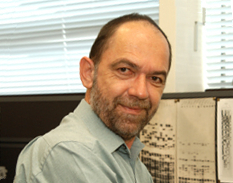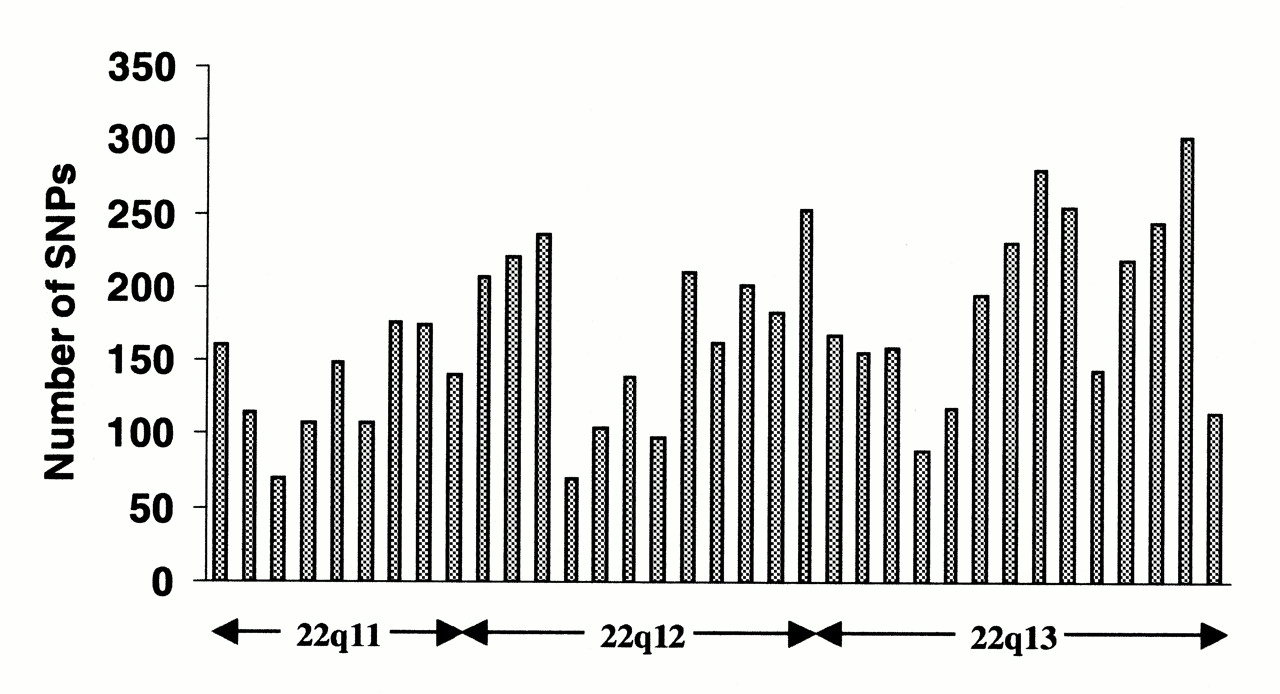|
Minisatellite
In genetics, a minisatellite is a tract of repetitive DNA in which certain DNA motifs (ranging in length from 10–60 base pairs) are typically repeated two to several hundred times. Minisatellites occur at more than 1,000 locations in the human genome and they are notable for their high mutation rate and high diversity in the population. Minisatellites are prominent in the centromeres and telomeres of chromosomes, the latter protecting the chromosomes from damage. The name "satellite" refers to the early observation that centrifugation of genomic DNA in a test tube separates a prominent layer of bulk DNA from accompanying "satellite" layers of repetitive DNA. Minisatellites are small sequences of DNA that do not encode proteins but appear throughout the genome hundreds of times, with many repeated copies lying next to each other. Minisatellites and their shorter cousins, the microsatellites, together are classified as VNTR (variable number of tandem repeats) DNA. Confusingly, ... [...More Info...] [...Related Items...] OR: [Wikipedia] [Google] [Baidu] |
Variable Number Tandem Repeat
A variable number tandem repeat (or VNTR) is a location in a genome where a short nucleotide sequence is organized as a tandem repeat. These can be found on many chromosomes, and often show variations in length (number of repeats) among individuals. Each variant acts as an inherited allele, allowing them to be used for personal or parental identification. Their analysis is useful in genetics and biology research, forensics, and DNA fingerprinting. Structure and allelic variation In the schematic above, the rectangular blocks represent each of the repeated DNA sequences at a particular VNTR location. The repeats are in tandem – i.e. they are clustered together and oriented in the same direction. Individual repeats can be removed from (or added to) the VNTR via recombination or replication errors, leading to alleles with different numbers of repeats. Flanking regions are segments of repetitive sequence (shown here as thin lines), allowing the VNTR blocks to be extracte ... [...More Info...] [...Related Items...] OR: [Wikipedia] [Google] [Baidu] |
Alec Jeffreys
Sir Alec John Jeffreys, (born 9 January 1950) is a British geneticist known for developing techniques for genetic fingerprinting and DNA profiling which are now used worldwide in forensic science to assist police detective work and to resolve paternity and immigration disputes.DNA pioneer's 'eureka' moment BBC. Retrieved 14 October 2011 Jeffreys is professor of genetics at the , and became an honorary of ... [...More Info...] [...Related Items...] OR: [Wikipedia] [Google] [Baidu] |
Microsatellite
A microsatellite is a tract of repetitive DNA in which certain Sequence motif, DNA motifs (ranging in length from one to six or more base pairs) are repeated, typically 5–50 times. Microsatellites occur at thousands of locations within an organism's genome. They have a higher mutation rate than other areas of DNA leading to high genetic diversity. Microsatellites are often referred to as short tandem repeats (STRs) by forensic genetics, forensic geneticists and in genetic genealogy, or as simple sequence repeats (SSRs) by plant geneticists. Microsatellites and their longer cousins, the minisatellites, together are classified as variable number tandem repeat, VNTR (variable number of tandem repeats) DNA. The name Satellite DNA, "satellite" DNA refers to the early observation that centrifugation of genomic DNA in a test tube separates a prominent layer of bulk DNA from accompanying "satellite" layers of repetitive DNA. They are widely used for DNA profiling in Loss of heterozygos ... [...More Info...] [...Related Items...] OR: [Wikipedia] [Google] [Baidu] |
Human Genome
The human genome is a complete set of nucleic acid sequences for humans, encoded as the DNA within each of the 23 distinct chromosomes in the cell nucleus. A small DNA molecule is found within individual Mitochondrial DNA, mitochondria. These are usually treated separately as the nuclear genome and the Human mitochondrial genetics, mitochondrial genome. Human genomes include both protein-coding DNA sequences and various types of non-coding DNA, DNA that does not encode proteins. The latter is a diverse category that includes DNA coding for non-translated RNA, such as that for ribosomal RNA, transfer RNA, ribozymes, small nuclear RNAs, and several types of RNA#Regulatory RNA, regulatory RNAs. It also includes Promoter (biology), promoters and their associated Cis-regulatory element, gene-regulatory elements, DNA playing structural and replicatory roles, such as Scaffold/matrix attachment region, scaffolding regions, telomeres, centromeres, and Origin of replication, origins of repl ... [...More Info...] [...Related Items...] OR: [Wikipedia] [Google] [Baidu] |
Satellite DNA
Satellite DNA consists of very large arrays of tandem repeat, tandemly repeating, non-coding DNA. Satellite DNA is the main component of functional centromeres, and form the main structural constituent of heterochromatin. The name "satellite DNA" refers to the phenomenon that repetitions of a short DNA sequence tend to produce a different frequency of the bases adenine, cytosine, guanine, and thymine, and thus have a different density from bulk DNA such that they form a second or "satellite" band(s) when genomic DNA is separated along a cesium chloride density gradient using buoyant density centrifugation#DNA separation, buoyant density centrifugation. Sequences with a greater ratio of A+T display a lower density while those with a greater ratio of G+C display a higher density than the bulk of genomic DNA. Some repetitive sequences are ~50% G+C/A+T and thus have buoyant densities the same as bulk genomic DNA. These satellites are called "cryptic" satellites because they form a band ... [...More Info...] [...Related Items...] OR: [Wikipedia] [Google] [Baidu] |
Somatic (biology)
In cellular biology, the term somatic is derived from the French somatique which comes from Ancient Greek σωματικός (sōmatikós, “bodily”), and σῶμα (sôma, “body”.) is often used to refer to the cells of the body, in contrast to the reproductive ( germline) cells, which usually give rise to the egg or sperm (or other gametes in other organisms). These somatic cells are diploid, containing two copies of each chromosome, whereas germ cells are haploid, as they only contain one copy of each chromosome (in preparation for fertilisation). Although under normal circumstances all somatic cells in an organism contain identical DNA, they develop a variety of tissue-specific characteristics. This process is called differentiation, through epigenetic and regulatory alterations. The grouping of similar cells and tissues creates the foundation for organs. Somatic mutations are changes to the genetics of a multicellular organism that are not passed on to its offspr ... [...More Info...] [...Related Items...] OR: [Wikipedia] [Google] [Baidu] |
Recombination Hotspot
Recombination hotspots are regions in a genome that exhibit elevated rates of recombination relative to a neutral expectation. The recombination rate within hotspots can be hundreds of times that of the surrounding region. Recombination hotspots result from higher DNA break formation in these regions, and apply to both mitotic and meiotic cells. This appellation can refer to recombination events resulting from the uneven distribution of programmed meiotic double-strand breaks. Meiotic recombination Meiotic recombination through crossing over is thought to be a mechanism by which a cell promotes correct segregation of homologous chromosomes and the repair of DNA damages. Crossing over requires a DNA double-stranded break followed by strand invasion of the homolog and subsequent repair. Initiation sites for recombination are usually identified by mapping crossing over events through pedigree analysis or through analysis of linkage disequilibrium. Linkage disequilibrium has iden ... [...More Info...] [...Related Items...] OR: [Wikipedia] [Google] [Baidu] |
Meiotic Crossover
Chromosomal crossover, or crossing over, is the exchange of genetic material during sexual reproduction between two homologous chromosomes' non-sister chromatids that results in recombinant chromosomes. It is one of the final phases of genetic recombination, which occurs in the ''pachytene'' stage of prophase I of meiosis during a process called synapsis. Synapsis is usually initiated before the synaptonemal complex develops and is not completed until near the end of prophase I. Crossover usually occurs when matching regions on matching chromosomes break and then reconnect to the other chromosome, resulting in chiasma which are the visible evidence of crossing over. History of discovery Crossing over was described, in theory, by Thomas Hunt Morgan; the term crossover was coined by Morgan and Eleth Cattell. Hunt relied on the discovery of Frans Alfons Janssens who described the phenomenon in 1909 and had called it "chiasmatypie". The term '' chiasma'' is linked, if not ... [...More Info...] [...Related Items...] OR: [Wikipedia] [Google] [Baidu] |
Transcription (genetics)
Transcription is the process of copying a segment of DNA into RNA for the purpose of gene expression. Some segments of DNA are transcribed into RNA molecules that can encode proteins, called messenger RNA (mRNA). Other segments of DNA are transcribed into RNA molecules called non-coding RNAs (ncRNAs). Both DNA and RNA are nucleic acids, which use base pairs of nucleotides as a complementary language. During transcription, a DNA sequence is read by an RNA polymerase, which produces a complementary, antiparallel RNA strand called a primary transcript. In virology, the term transcription is used when referring to mRNA synthesis from a viral RNA molecule. The genome of many RNA viruses is composed of negative-sense RNA which acts as a template for positive sense viral messenger RNA - a necessary step in the synthesis of viral proteins needed for viral replication. This process is catalyzed by a viral RNA dependent RNA polymerase. Background A DNA transcription unit encoding ... [...More Info...] [...Related Items...] OR: [Wikipedia] [Google] [Baidu] |
Internal Variants
{{disambig ...
Internal may refer to: *Internality as a concept in behavioural economics *Neijia, internal styles of Chinese martial arts *Neigong or "internal skills", a type of exercise in meditation associated with Daoism * ''Internal'' (album) by Safia, 2016 See also * *Internals (other) *External (other) External may refer to: * Externality, in economics, the cost or benefit that affects a party who did not choose to incur that cost or benefit * Externals, a fictional group of X-Men antagonists See also * *Internal (other) Internal may ... [...More Info...] [...Related Items...] OR: [Wikipedia] [Google] [Baidu] |
Replication Slippage
Replication may refer to: Science * Replication (scientific method), one of the main principles of the scientific method, a.k.a. reproducibility ** Replication (statistics), the repetition of a test or complete experiment ** Replication crisis * Self-replication, the process in which an entity (a cell, virus, program, etc.) makes a copy of itself ** DNA replication or DNA synthesis, the process of copying a double-stranded DNA molecule *** Semiconservative replication, mechanism of DNA replication ** Viral replication, the process by which viruses produce copies of themselves * Replication (metallography), the use of thin plastic films to duplicate the microstructure of a component * Self-replicating machines Computing * Replication (computing), the use of redundant resources to improve reliability, fault-tolerance, or performance * Replication (optical media) In optical disc manufacturing, replication is the process of producing discs via methods that do not involve "burning" ... [...More Info...] [...Related Items...] OR: [Wikipedia] [Google] [Baidu] |




